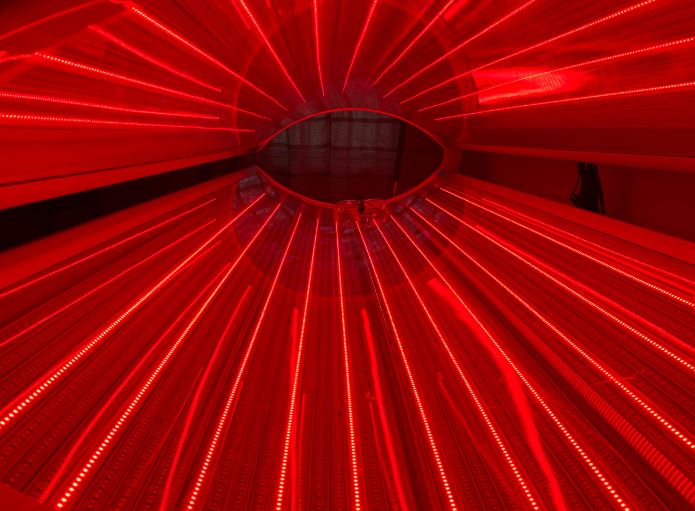
On the Pulse with Red Light
Share
In recent years, the popularity of Red Light Therapy has increased hugely as a modality for skin rejuvenation.
At-home devices, from small, hand-held devices to LED bulbs, masks, and panels, are all the rage for pepping up your skin tone and texture and reducing pigmentation.
In medical circles, however, pulsed light lasers are favoured over continuous wave lasers for various therapeutic applications, with better outcomes. So, should we not use pulsed LED light for our red light therapy at home?
Firstly, let’s not confuse IPL with pulsed LED. I’m not talking about Intense Pulsed Light, which is a different modality entirely, often used to treat spider veins, facial hair and facial lines and wrinkles. I am simply referring to low level laser therapy [LLLT], also known as photobiomodulation therapy, or red light therapy.
The concept of super-pulsing LED was originally developed to limit the amount of heat produced in tissue, reducing thermal damage, so lasers could be used for longer. Clearly tissue overheating is not a problem for at-home LED light therapy devices, such as LED masks for skin rejuvenation or LED panel skincare devices, as the strength of devices would never be at a level to cause tissue damage. So, do we really need it?

Well, for medical applications from wound healing to treating stroke patients, aside from the safety advantages of reduced tissue heating, pulsed light has been shown to be more effective than continuous wave.
Better Skin Penetration
Brondon's in vitro study comparing continuous wave and pulsed wave found pulsed light better able to penetrate through melanin filters, indicating that pulsing may be beneficial to penetrate melanin rich skin. This is what I refer to as the 'Heineken effect' – pulsed light reaches the parts that non-pulsed light doesn’t reach!
Upregulation of ATP & Accelerated Cell Proliferation
There are several studies which support that pulsed LED light is better for healing and repair. Essentially, there are two aspects required for wound healing, the first being the production of cellular energy in the form of ATP, and the second being cell proliferation, which for skin will lead to the deposition of collagen.
Data from Keshri's in vivo pulsed light studies shows increased ATP levels over non-pulsed light and demonstrated that pulsed light at a frequency of 10Hz promoted wound repair and healing more so than non-pulsed light. More than two and a half thousand women were involved in a study which treated episiotomies with pulsed light – that’s the cut the doctor often gives you during the 2nd stage of labour to make the birth easier. These research studies used pulsed light at various frequencies from 10 to 100Hz and concluded that pulsed light was more effective than continuous light for wound healing.
There are several studies that support that pulsed LED light accelerates cell proliferation more so than its continuous wave counterpart. Ueda & Shimizu demonstrated that pulsed light (1Hz and 8 Hz) is significantly superior to continuous wave when it comes to stimulating cell proliferation and bone formation in vitro. Brondon’s studies with the melanin filters also concluded that cell proliferation was stimulated more by pulsed light
I know that many of us like to use red light after microneedling, to help reduce inflammation. Now that you understand pulsed LED gives an even better response for wound healing, then definitely consider using pulsed LED light after microneedling! Whilst we talk about a wound healing response though, it is also relevant to skin rejuvenation in general. Skin rejuvenation requires the same elements of upregulation of ATP and fibroblast proliferation for anti-aging.
Improved Uptake of Nanoparticles & Nutrients
From a skin rejuvenation perspective, one of the interesting things about pulsed LED light is that it can help with the uptake of skincare ingredients. The impact of pulsed light on the uptake of nanoparticles was discovered from drug delivery research for chemotherapy. One of the earlier studies, by Miyamoto, uses a photosensitizer, a coloured dye, to measure the uptake of the dye with photobiomodulation. What we see is that much more of the dye enters the cell during pulsed irradiation. So pulsed red light irradiation is often used to give better drug delivery of chemotherapy drugs.
Better skin penetration, upregulation of ATP, accelerated cell proliferation, and improved uptake of nanoparticles & nutrients in pulsed light mode are four good reasons why we should consider using pulsed LED light for our red light therapy treatments.
But why does pulsed light offer a better outcome? In Hashmi’s comprehensive review of many pulsed light studies, the logic in favour of pulsed light is that;
‘cells may need periods of rest, without which they can no longer be stimulated further.’
The authors discuss that there may be biological explanations for the improved efficacy of pulsed light over non-pulsed light.
The frequency of pulsed light used in research studies varies from 2.5-10,000 Hz, with improved effects of pulsed light over continuous wave being apparent across this range.
Research suggests that the improved outcomes may be due to pulsed light having a similar frequency to natural frequencies, which exist in biological systems.
To me, this sounds remarkably like the principles of microcurrent, whereby the success of microcurrent for skin rejuvenation depends largely on the modality mimicking the body’s own electrical currents. Either way, the biological response to pulsed light cannot be ignored.

Regarding biological systems with natural frequencies, one such system is mammalian brain waves.
Mammalian brain waves have specific frequencies, with alpha, beta, delta and theta brainwaves, ranging from 1 to 40 Hz. It is possible that the resonance between the frequency of the light pulses and the frequency of the brain waves is similar. This may explain some of the results with transcranial low level pulsing red light therapy.
Another theory is centred around ion channels. Potassium and calcium ion channels in the mitochondria may be involved in the cellular response to low level light therapy.
In some ion channels, a pore is opened by a ‘gate’, which is opened or closed for just a few milliseconds. Similarly, pulsed light is ‘on’ for a period of a few milliseconds, so the body may respond more favourably to this imitation of kinetic behaviour.

Author of the science paper ‘Red light and green tea, a powerful duo in skin rejuvenation’ which proved green tea skicare benefits, Andrei Sommer, and his team of photobiomodulation scientists at the University of Ulm, have been using pulsed red (670nm) LED light in their research studies for many years to increase the uptake of cancer drugs.
One of the cancer drugs that Sommer works with is Epigallocatechin gallate [EGCG], the main flavonoid in green tea, which has been shown to have anti-mutagenic properties. Sommer’s research on flavonoids and light therapy shows that pulsed light forces cells to uptake the drugs, a phenomenon that Sommer refers to as Transmembrane Convection.
Sommer shared with Maysama that their research confirms that pulsed LED light aids the absorption of micronutrients and, whilst this light-cell-pump ‘delivery system’ is used in medical applications to increase drug uptake, Sommer explained that it can also be used to increase the uptake of skincare ingredients, increasing the efficacy of skincare products.
Let's look at what happens when we use pulsed red or near infrared LED light.
LED light has two physiological effects on cells. Firstly, it increases the volume of the cytosol, the fluid inside the cell and, secondly, it increases the viscosity of the interfacial water layers, particularly within mitochondrial membranes.
So, when we shine red-NIR light on cells, the cells expand as the volume of the cytosol increases. And, when the light is off, the cell contracts. Effectively, when we use red-NIR in pulsed mode, cells are ‘breathing’ in and out as they expand and contract. During periods of darkness when the pulse is ‘off’ nanoparticles surrounding the plasma membrane are literally sucked into the cell.

Effect of Pulsed LED Light on Skincare Absorption
So there are many pulsed LED skincare benefits over non-pulsed light to help with the uptake of active ingredients, increasing the efficacy of your skincare.
Sommer explains that pulsed LED light has benefits for optimising the production of ATP, in addition to increased red light therapy product absorption.
Whilst the exposure of cells to biostimulatory levels of LED light normally activates cellular functions, the bi-phasic dose response shows the negative impact of prolonged LED light exposure in a single treatment session.
The inhibitory effect is due to a build-up of free radicals, also known as Reactive Oxygen Species [ROS].

Bi-phasic dose response
Low and high levels of free radicals affect the rate at which ATP, the cell’s energy molecule, is produced by the cell. High levels of free radicals increase the viscosity of the interfacial water layers in our mitochondrial membrane (and between cells).
This makes the water layers behave more like treacle and slows down the action of the enzyme ATP synthase, the nanomotor responsible for making ATP.
Whilst free radicals are important signalling molecules and critical to the beneficial action of red light therapy, extended exposure to excess free radicals will reduce the beneficial action of your red LED light device.
An overabundance of free radicals from red light exposure will reduce the rate at which ATP is produced, slowing down the proliferation of dermal skin cells (fibroblasts) and leading to oxidative stress.
Prolonged oxidative stress leads to damage to cellular components, including lipids, proteins and DNA, so ideally, we want to buffer excess free radicals produced during our red light therapy treatment.
For shorter irradiation times the inhibitory effect of free radicals is negligible due to the short lifetimes. Using pulsing red light therapy treatment offers an advantage for optimising the beneficial effects during biostimulation, with none of the down-sides associated with free radical build-up. Of course, proper red light therapy dose optimisation is a must.

Diagram courtesy of Andrei P. Sommer, 'Tuning the mitochondrial rotary motor with light'.
Pulsed light offers an advantage over non-pulsed light, for optimising the beneficial effects of photobiostimulation. The diagram above shows what happens to ATP production and corresponding ROS levels during pulsed light. When the light is ON, a short burst of ROS is initiated and mitochondrial ATP is elevated. When the light is OFF, the cell uses up its ATP store and ROS levels fall off. In this way, pulsed light allows for optimisation of ATP output, with none of the downsides of ROS build-up.
As science studies support, photobiomodulation in pulsed light mode offers a significant advantage over non-pulsing red light therapy treatments for targeted skin rejuvenation. In summary, pulsed light:
- Aids light penetration
- Increases the absorption of cosmetic products
- Upregulates ATP production
- Mitigates an overabundance of ROS produced by the action of red-NIR devices and
- Accelerates cell proliferation.
Understanding the pulsed LED light benefits over continuous LED light, Maysama incorporates pulsed light in all our LED beauty devices from Maysama’s LED Bian Stone Gua Sha, Maysama Urchin, and Maysama’s LED Hair Growth Comb, to Maysama's Pulsed LED Light Therapy Panel.
Check out Maysama’s LED beauty device range here, and enjoy in rejuvenations provided by pulsing red light therapy:
SHOP THE EDIT
Maysama Bian Stone LED Gua Sha

image courtesty of @taliashani [instagram]
Maysama Urchin - Sonic Cleansing & Skin Rejuvenation Device

References cited
Pulsing influences photoradiation outcomes in cell culture - PubMed (nih.gov)
Pulse irradiation of low-power laser stimulates bone nodule formation - PubMed (nih.gov)
Pulsing influences photoradiation outcomes in cell culture - PubMed (nih.gov)
Effect of Pulsing in Low-Level Light Therapy - PMC (nih.gov)
Research References
- https://www.ncbi.nlm.nih.gov/pmc/articles/PMC5115773/
- https://www.liebertpub.com/doi/abs/10.1089/10445470360516725
- https://www.researchgate.net/publication/11954696_Pulse_irradiation_low-power_laser_stimulates_bone_nodule_formation
- https://pubmed.ncbi.nlm.nih.gov/31107170/
- https://pubmed.ncbi.nlm.nih.gov/10672529/
- https://www.semanticscholar.org/paper/Breathing-Volume-into-Interfacial-Water-with-Laser-Sommer-Hodeck/7def49a1f0c59e3ae75426694d29bc84deb36b6e
- https://pubmed.ncbi.nlm.nih.gov/26154113/
- https://pubmed.ncbi.nlm.nih.gov/20934473/








